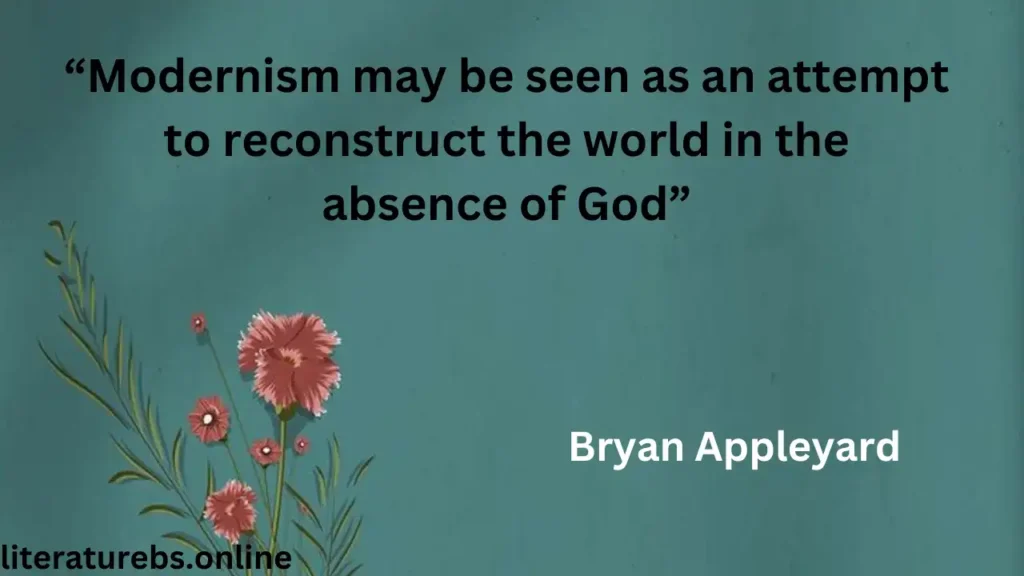Modernism in Literature
Modernism in literature is a broad and complex movement that emerged in the late 19th and early 20th centuries as a reaction against traditional forms and subjects in art, literature, and culture. This movement is characterized by a deliberate break from established conventions and an exploration of new techniques and perspectives.
Key Characteristics:
- Fragmentation:
Modernist literature often features fragmented narrative structures, reflecting the complexities and uncertainties of modern life. This can include disjointed timelines, multiple perspectives, and stream-of-consciousness writing.
- “Life is not a series of gig lamps symmetrically arranged; life is a luminous halo, a semi-transparent envelope surrounding us from the beginning of consciousness to the end.”
- Subjectivity and Inner Experience:
There is a focus on the inner experiences and subjective consciousness of characters. Writers like James Joyce and Virginia Woolf delve deep into the minds of their characters, exploring thoughts and emotions in an intimate and sometimes disordered manner.
“I am not a hero, but in a certain sense I have sat at the feet of a hero.”
James Joyce, “A Portrait of the Artist as a Young Man”
- Formal Experimentation:
Modernist writers experimented with form and style, breaking away from traditional plot structures and experimenting with language. Techniques such as stream of consciousness, unreliable narrators, and non-linear timelines are common.
“A novel must be exceptionally good to live as long as the average cat.”
Hugh Walpole
- Themes of Alienation and Dislocation:
Modernist works often explore feelings of alienation, dislocation, and existential angst. This reflects the disillusionment of the post-World War I era and the rapid changes in society, technology, and politics.
“The horror! The horror!”
Joseph Conrad, “Heart of Darkness”
- Ambiguity and Multiple Meanings:
Modernist texts frequently employ ambiguous and open-ended narratives, requiring readers to engage more actively in interpretation. The meaning is often not explicit, and readers must piece together the story themselves.
“Poetry is not a turning loose of emotion, but an escape from emotion; it is not the expression of personality, but an escape from personality.”

Historical Background and Events Leading to Modernism:
Modernism emerged during a time of significant upheaval and change, profoundly influenced by historical events and cultural shifts:
World War I:
The devastation and trauma of World War I (1914-1918) shattered many people’s faith in progress, rationality, and the perceived order of Western civilization. The horrors of trench warfare and the massive loss of life prompted a widespread sense of disillusionment and a questioning of traditional values and beliefs.
Quote: “This is the way the world ends / Not with a bang but a whimper.” — T.S. Eliot, “The Hollow Men”
Industrialization and Urbanization:
Rapid industrialization and urbanization transformed societies, leading to a sense of alienation and fragmentation. The movement of people from rural areas to cities disrupted traditional ways of life and created new social dynamics.
Quote: “The cities of men are far too full of machines and tall houses.” — D.H. Lawrence
Advances in Psychology:
The work of Sigmund Freud and Carl Jung introduced new ideas about the human psyche, emphasizing the importance of the unconscious mind, dreams, and repressed desires. These theories influenced modernist writers to explore deeper, often darker, aspects of human consciousness.
Quote: “The interpretation of dreams is the royal road to a knowledge of the unconscious activities of the mind.” — Sigmund Freud
Technological Advances:
Innovations such as the telephone, automobile, and cinema altered daily life and perceptions of reality. These changes are often reflected in modernist literature’s themes and techniques.
Quote: “We are the hollow men / We are the stuffed men / Leaning together / Headpiece filled with straw.” — T.S. Eliot, “The Hollow Men”
Influential Authors and Works:
James Joyce:
Notable works: “Ulysses,” “A Portrait of the Artist as a Young Man”
Joyce’s use of stream of consciousness and intricate structuring, particularly in “Ulysses,” exemplifies modernist experimentation with narrative form and language.
Virginia Woolf:
Notable works: “Mrs Dalloway,” “To the Lighthouse”
Woolf’s exploration of characters’ inner lives and her innovative narrative techniques highlight the subjectivity and fluidity of human experience.
T.S. Eliot:
Notable works: “The Waste Land,” “The Love Song of J. Alfred Prufrock”
Eliot’s poetry is marked by its dense allusions, fragmented structure, and themes of decay and regeneration.
Franz Kafka:
Notable works: “The Metamorphosis,” “The Trial”
Kafka’s works often depict nightmarish scenarios and bureaucratic absurdities, exploring themes of alienation and existential dread.
William Faulkner:
Notable works: “The Sound and the Fury,” “As I Lay Dying”
Faulkner’s use of multiple perspectives and non-linear storytelling contributes to the complexity and depth of his exploration of Southern life.
Critics and Reception:
Modernism in literature faced mixed reactions from critics and the public:
Initial Criticism:
Early modernist works were often met with confusion and hostility. Critics and readers accustomed to traditional narrative forms found modernist texts challenging and sometimes incomprehensible.
Quote: “Incomprehensible gibberish!” — Early 20th-century critic on “Ulysses”
Recognition and Canonization:
Over time, modernist literature gained recognition and acclaim for its innovative techniques and profound insights. Works by Joyce, Woolf, Eliot, and others are now considered classics, studied for their artistic achievements and cultural significance.
Quote: “For his work which, in new forms of fiction and the art of description, conveys an impression of the present-day human situation, he [William Faulkner] has earned the award of the Nobel Prize for Literature.” — Nobel Prize Committee
Conclusion:
Modernism represents a radical departure from past literary traditions, embracing complexity, innovation, and a deep engagement with the inner workings of the human psyche. It remains a pivotal movement that has shaped the course of literature and continues to influence writers today. The themes of alienation, dislocation, and the search for meaning in a fragmented world resonate with contemporary readers, ensuring the enduring relevance of modernist literature.
